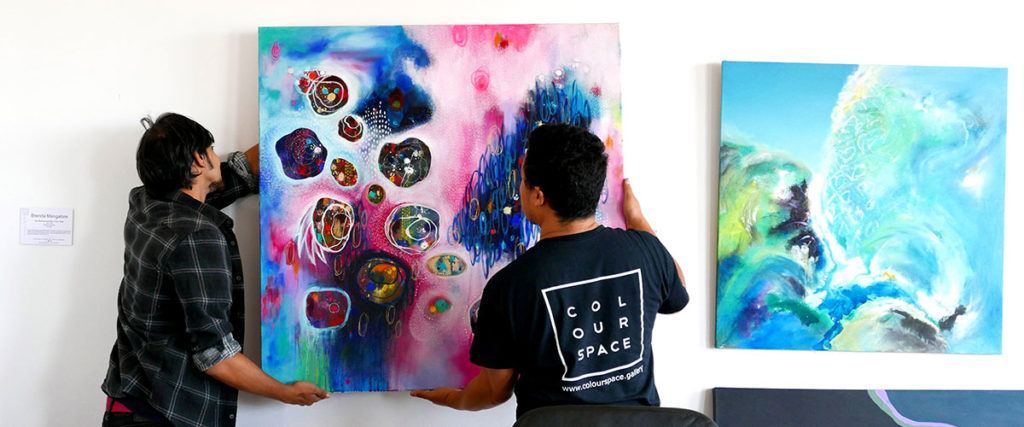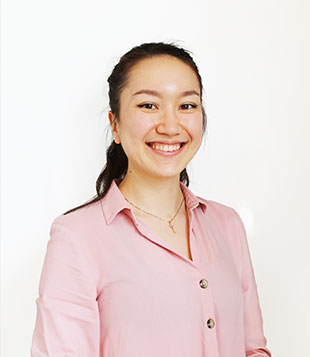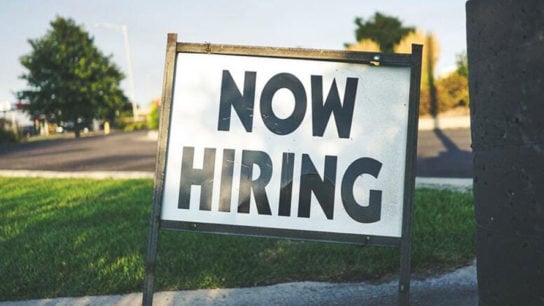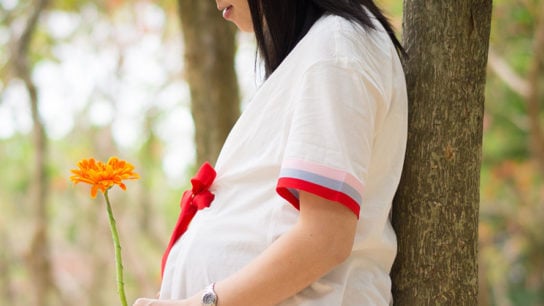Melbourne-based art rental startup, ColourSpace Gallery, helps businesses look and feel good with art while empowering local emerging artists across Australia.
Fake plants, ergonomic chairs, and inspirational quotes are the stuff of modern workplaces. But for Scott Ko, creative strategist and founder of Australia’s first art social enterprise ColourSpace Gallery, offices still lack one fundamental ingredient: artwork. Rotating artwork, to be precise.
Founded in 2016, ColourSpace was borne from a passion to build healthy and engaging corporate cultures while sustainably supporting Australia’s flagging arts industry, particularly female, LGBTQI+, and indigenous artists trying to get their foot in the door. The startup has contributed over AUD 45,000 in revenue to artists through royalties and sales to date, with 10% going towards art programmes for local and disadvantaged communities. Last year, ColourSpace made headlines on Smart Company for tripling its revenue and was on track for 400% growth before COVID-19 hit. Nonetheless, it has managed to keep all of its clients, revitalising the walls of the Reserve Bank of Australia, the Victorian Governor Solicitor’s Office, and Melbourne’s Grand Hyatt, to name a few. Hive Life sat down with Scott to uncover the hidden barriers of elitism and diversity that emerging artists in Australia face, and the humanising power of art in the workplace.
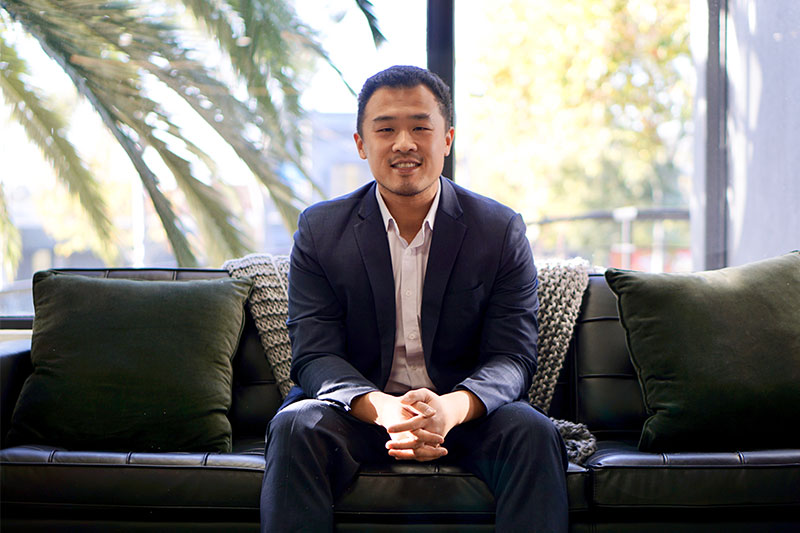
Scott Ko, ColourSpace Gallery Creative Strategist & Founder
Walk us through your founding story. As someone with no background in art, what inspired you to create ColourSpace Gallery in 2016?
I began my career at Accenture working as a business analyst, but never quite understood exactly what I was doing or how it was providing value to the broader community. I then went on to do a master’s degree in marketing where I became really interested in human psychology, innovation, and the way people interact, and joined public value consultancy Cube Group in 2015. It was while working there that I realised we were paying someone AUD 50 to change fake flowers in the office reception area every month. Yet, the artwork on the walls hadn’t been changed in almost a decade. Despite being a cutting-edge company, people were still being greeted by the same dusty canvas whenever they walked through the door because changing it was seen as ‘too hard’. At the same time, I’d also been talking to some friends who were artists and learned about the challenges they faced getting their art out.
One day when I was in the shower, I had a lightbulb moment: what if I could change the art in a space like the person changing fake flowers? While I didn’t have an arts background, I knew that some of the greatest artists were entrepreneurs and innovators in their own right. So, if art represented innovation, changing the artwork in a space could represent throwing new ideas into what is traditionally a staid environment. But more than that, we could do good for the community as well by creating ongoing social and economic opportunities for local Australian artists from all walks of life.
How does ColourSpace work exactly?
Our core mission is to change the way people engage with art. We want to make art more accessible to everyone because we believe that it is a glue that enriches our lives and brings vibrancy to society. And we do that by providing art ‘as a service’. What that means is, every three months, we deliver fresh artwork from local emerging artists to people in office and communal environments, transforming them into pseudo galleries. We look after the curation, transportation, insurance, and installation, and everything is managed through a custom-built matching platform. For offices, they get a constantly refreshing workspace that engages staff and improves wellbeing, all without the need for costly refurbishments. For artists, we provide new opportunities and channels to showcase their artwork and generate alternative sources of income. There are no exhibition, listing, or transportation fees, and artists earn 25% of all revenue from our subscription service as royalties. If their artwork sells (which happens frequently), they receive 75% of the sale price, which is displayed on a plaque alongside details about who you are, your motivations, and your medium.

Featured artist: Mirabela Varga
How do you determine which art is ‘suitable’ for a specific environment?
We work very closely with our clients to understand what type of environment they want to create. Let’s say they are a law firm, they might want artwork that falls on the more conservative side of the spectrum; something safe, inoffensive, and non-confrontational. This gives us a series of ‘tags’ which we then curate around. We don’t say, “here are 500 pieces of artwork, please go and decide” because that can be quite stressful. Instead, we make it easy by giving them maybe a handful of options for approval. But, the joy of our role is that after two or three rotations, we start to bring in art that they may never have said yes to at the start.
One of the coolest things I’ve found is that, after a while, our clients’ tastes start to expand. And with that, their confidence in being open and supportive of what is displayed. It’s incredible to see how the simple act of changing artwork has helped subtly increase the culture and expressiveness in a business. In their openness to experiment with different types of art, they too convey messages of being open and contemporary.
What are some of the biggest obstacles emerging artists face in Australia right now?
The biggest obstacles emerging artists face are in many ways not unlike that of small business owners today: finding an audience, finding meaningful opportunities to get their work out there and make money, etc. For a very long time, the model was defined by this idea of ‘patronage of the arts’, whether that’s from government or elite gallery institutions. But now, especially during COVID-19 where a lot of different sectors are facing drastic funding cuts, it’s harder than ever for emerging artists to get their foot in the door. Their only options are to either go online (which is an entirely different customer experience) or pay to exhibit their art in a gallery that will likely close down. Even then, galleries in Australia typically charge up to a 50% commission on artworks sold.
There is also the ‘ivory-towerness’ of fine art to reckon with. Elite art institutions are constantly vying with one another in a kind of ‘art war’ to promote the five or six artists they represent as much as possible. This misleads a lot of artists into thinking that exclusivity is the goal, as opposed to inclusivity and making art accessible to the wider public. I think this issue also speaks to the makeup of art institutions and their lack of diversity. I have heard from colleagues about situations where a gallery worker with an Asian background, for instance, is told their opinion about Asian art doesn’t matter because “we know more about Asian art than you do”. And it becomes awkward because they clearly don’t. In fact, there have been cases where established institutions have accidentally sold fake artwork because they didn’t know enough about the origin and cultural heritage. When someone from that culture points it out, they are sidelined because their background isn’t ‘traditional’. Subsequently, the way people interpret and engage with art today is still very much through a Western lens. If you look at Indian art, for example, a lot of it revolves around stories, so without an appreciation of those stories, it becomes harder to appreciate the artwork itself.
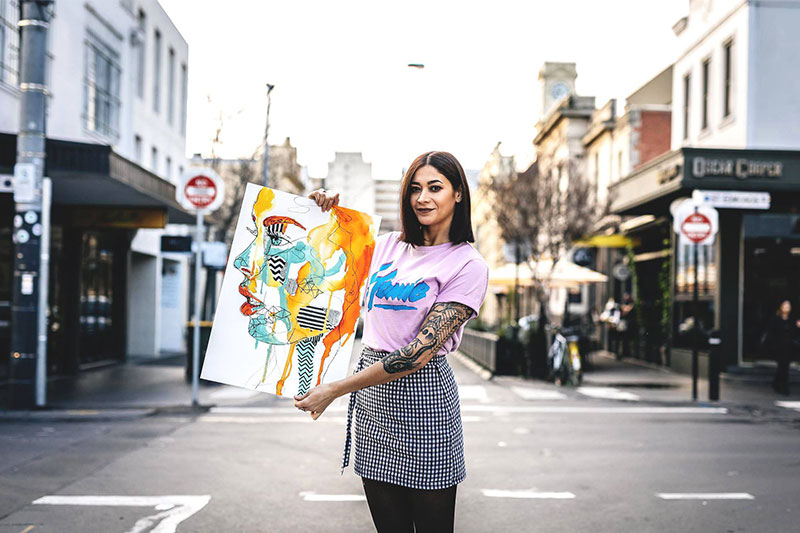
Featured artist: Justina Maku Bisset
How does ColourSpace support artists from non-traditional backgrounds and ensure diversity in its curations?
Our focus is on ‘lifting the tide’ for all emerging artists, so the types of artists we represent naturally come from a diverse range of backgrounds. As of 2019, our community base comprised of 81% female, 54.2% aged over 45, 12.5% CALD (Culturally and Linguistically Diverse), 12.5% refugee or first-generation migrant, and 8.3% LGBTQI+ artists. We are also members of the Aboriginal Arts Association of Australia, and work closely with indigenous art communities like Baluk Arts to help give them more control over the artworks and stories they share.
Indigenous art is an especially sensitive topic here in Australia. We often get asked if we provide indigenous art and our first question back is always: “What do you mean by ‘indigenous art’?” If we were to display, say, this piece of pop art by an Aboriginal artist, is that okay? Or do you specifically mean something that looks like traditional indigenous art? Just because you’re requesting indigenous art doesn’t necessarily mean you are supporting indigenous artists, so we try to help our clients understand the origins of a piece of art and come at it from a place of education. Again, because of how our rotations work, we’re able to expose people to a diversity of perspectives on a regular basis and say, “You may not have thought this artwork was from an indigenous artist, but it is – and here is their story”.
Any memorable or touching examples of artists you’ve helped?
For sure! I remember there was one artist we worked with who was a cancer survivor and painted as a form of therapy during her recovery process. When we broke the news that her artwork had been selected for display in the Victorian Governor Solicitor’s Office, she was like, “What is going on? Never in a million years would I imagine my art being on the walls of a place like that!” It motivated her to keep creating, and that’s been the case for a lot of our artists. According to an internal survey we conducted, around 35% of artists created art for ‘mental health or therapy reasons’, and over 80% reported feeling ‘validated, joyous, and motivated to continue creating art’ once their art was on display. Realising that, for me, was extremely powerful and gratifying.
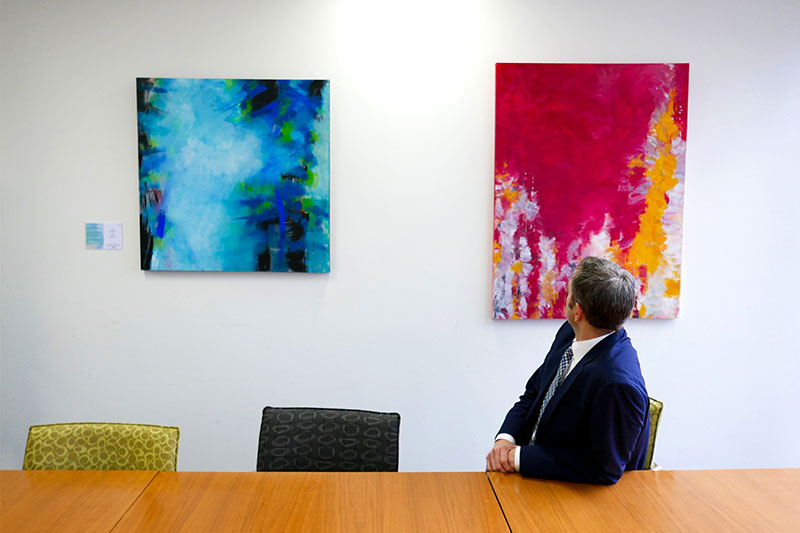
Featured artist: Anne-Maree Wise
Art can have a profound impact on those who create it, but what about those who consume it? Why should businesses invest in art for their workplace?
From a scientific standpoint, there are countless studies on the role of art in reducing stress and improving productivity in built environments – the most significant one being the World Health Organisation’s sweeping review of over 3,000 studies globally in 2019. Up to 45% of Australian workers experience some form of mental illness, costing businesses AUD 13 billion a year, but if we were to put more money into making our workplaces mentally healthy, every dollar spent would reportedly yield a 230% return on investment. By no means are we saying that art will save a business from going bust. What we do know is that there needs to be a holistic approach to mental health and wellbeing, and art can help with that.
Another really compelling angle is around what art can say about a business’ culture. Far from being just ‘a picture on a wall’, art (in addition to other design elements in a workplace) sends a message of dynamism, richness, and joy to anyone – employee, client, or prospective talent – who walks through the door. For leaders, it signals to their teams that they are willing to do what they can to broadly support them. It’s not just, “here’s a meditation workshop once a month,” but rather, “we’re going to look at the environment you’re in and invest in making it a little more engaging and stimulating for you because it’s important to us”. Art humanises the workplace, which will be crucial as people return to offices that are colder and more sterile than ever as a result of social distancing and safety measures. It sends that message of, “Welcome back. Yes, we’ll need to be socially distant, but that doesn’t mean we can’t still connect as humans.”
In ColourSpace’s Definitive Guide to Reopening Offices, it talks about the importance of so-called ‘creative collisions’. Could you elaborate on what is meant by that?
I think one of the biggest losers from social distancing and remote work is this concept of ‘creative collisions’. Similar to ‘water cooler conversations’, these refer to spontaneous, unplanned situations where people build meaningful connections with one another, whether that’s overhearing someone talk about a shared hobby, having a whinge while riding the elevator, or a debate over a piece of artwork in the corridor. And you can’t necessarily force those little things; it arises organically from people being in a shared space. No doubt most teams will have virtual team meetings and check-ups in place, but I think most people can agree that when we’re on a Zoom call, it’s a different protocol. One person speaks at a time, so you can’t really interrupt each other. There’s none of that roughness that enables genuine human connection – nor genuine creativity for that matter. Businesses are always talking about the future of work being ‘creative’, but what does that mean? Is it sitting people down in an ‘innovation corner’ and telling them to come up with 10 creative ideas within the hour? I think the meta nature of creativity lies in the play. It lies in the mess, and the conflict and the experimentation. That’s what will separate us from robots as we move into an increasingly automated world, and I don’t know if businesses are good at cultivating that as yet.
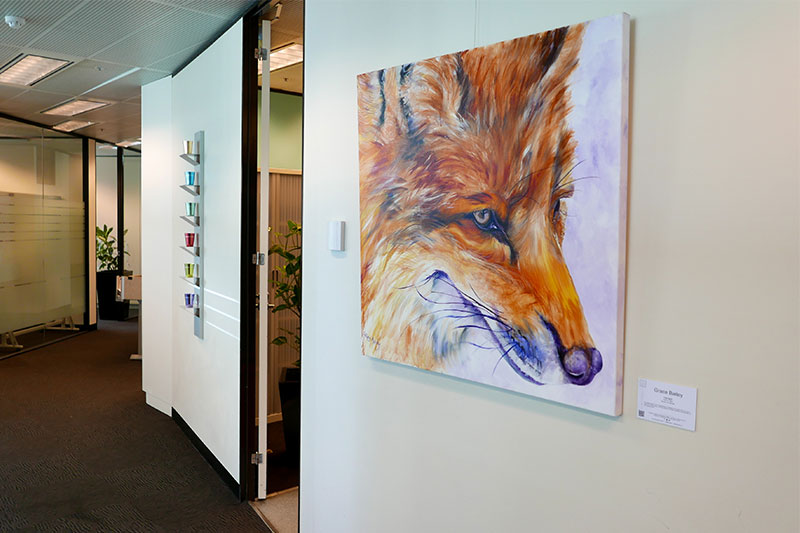
Featured artist: Grace Bailey
You’ve recently launched a new pilot program with the Liverpool Hospital. Can you tell us more about that?
If there’s one thing we know about hospitals, it’s that they are generally very drab environments. Given the evidence that art heals, we wanted to see if we could apply that same concept of using art to brighten up hospital wards and enrich patients’ quality of life. So, we approached Liverpool Hospital (which was looking at a redevelopment process) with the idea of turning one of their wards into an exhibition space for local artwork, and they said yes! Within a few weeks of launching our joint Exhibition Program, we’d received over 250 submissions from artists in the area and were able to install 20 odd pieces of art in their Mental Health Ward and Children’s Ward.
Feedback from the hospital has been fantastic so far. The artists also really value the opportunity to support their local space in a way that benefits patients, visitors, and staff too. It’s a win-win for all involved and that, for us, encapsulates everything ColourSpace is about.
This was very much a collective effort, so I want to give a couple of shout-outs to Liverpool Hospital for taking a risk with us; to the South Western Sydney Local Health District (SWSLHD), Casula Powerhouse Arts Centre, Liverpool City Council, and to Miriam Cabello in particular, without whom this would not have been possible.
What is one piece of advice you would give to struggling artists in Australia?
My advice would be to (a) keep at it, and (b) don’t be afraid of getting out there and talking to more people. I want to advocate very fiercely for the right to freedom of artistic expression and creativity. At the same time, if that creativity is in a pure vacuum with no regard for who it touches, then the only person it benefits is the artist themself. You have to remember that a lot of people genuinely don’t understand art – and I used to be one of them! I used to walk into a gallery, look at a piece of art and think, ‘I don’t get any of this’. Even the plaque explaining it felt like this thesaurus soup of words. From an accessibility perspective, then, I would encourage artists to venture out of their creativity ‘bubble’ every so often and talk to people. How are they engaging with your work? What draws them in? It could be the artist’s story, a special technique, or even a sense of nostalgia. Whatever it is, the answer might surprise you!

Featured artist: Jamie Eastwood
Future plans?
It all comes back to our vision: transforming the world’s cities into galleries and educational spaces. In the next 5-10 years, especially coming out of lockdown, we’ll focus on bringing art into schools, universities, hospitals, offices, and coworking spaces, in a way that elevates local artists and re-engages the public. We’re also looking at expansion into Southeast Asia. I was in Thailand last year as part of the Collider Accelerator programme and managed to connect with a local business partner there. From what I’ve seen, Thai artists have it even tougher because there isn’t much government support, so let’s test our model – a Bangkok supported by Bangkok artists that, in turn, supports the arts.
For more information on ColourSpace, head over to www.colourspace.gallery.
Banner photo featured artists:
Brenda Mangalore (left); Oliver Ashworth-Martin (right)
Related Articles
The Woman Revitalising Australia’s Art Scene With Her All-Women Art Gallery
Embrace: Photography Project Celebrates Gender Identity & Authenticity
#TattooGirlsJP: Breaking the Stigma Against Tattooed Women in Japan
